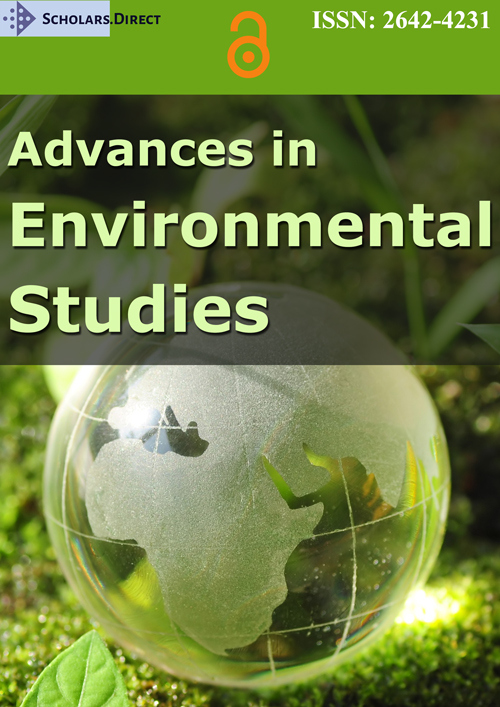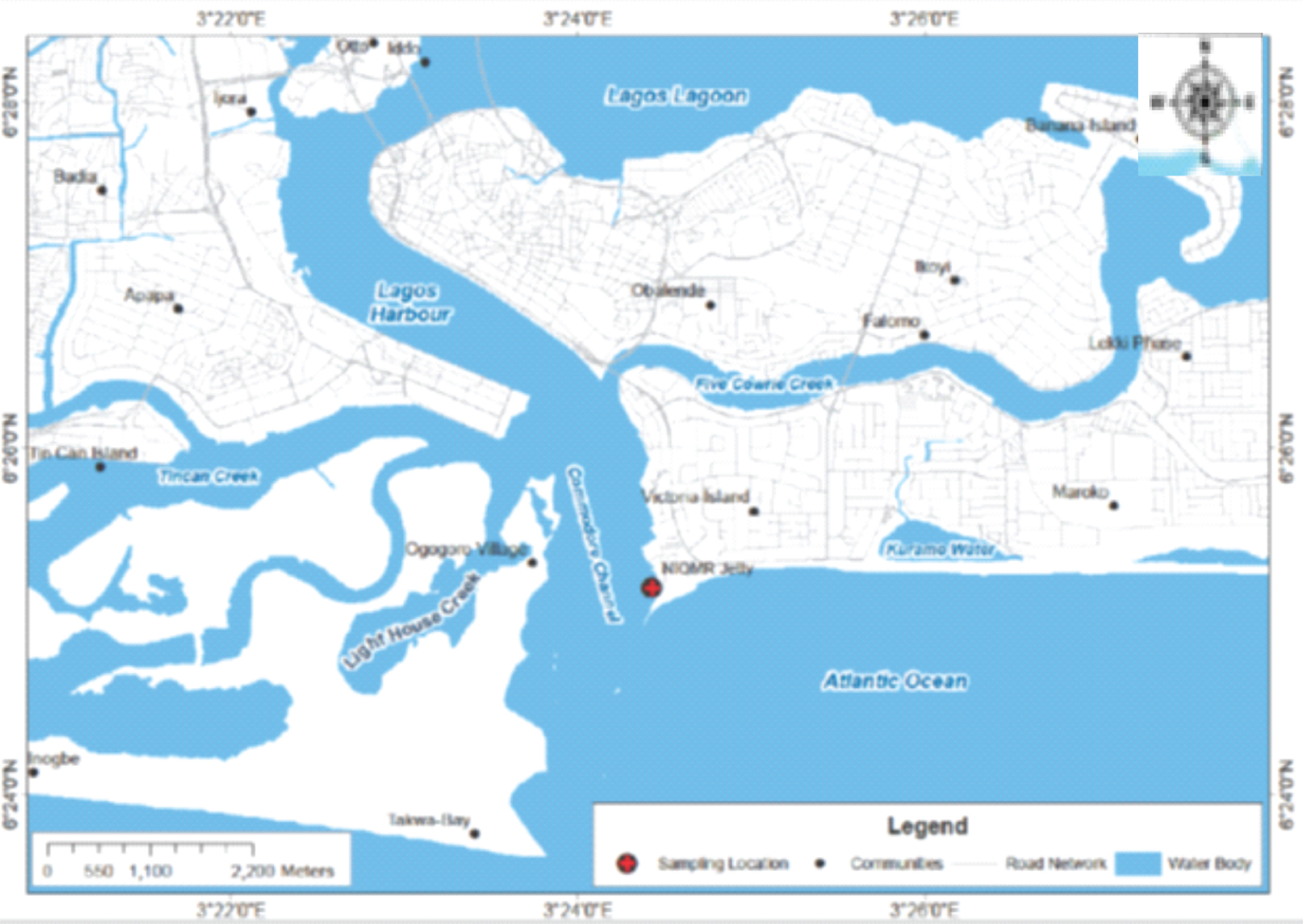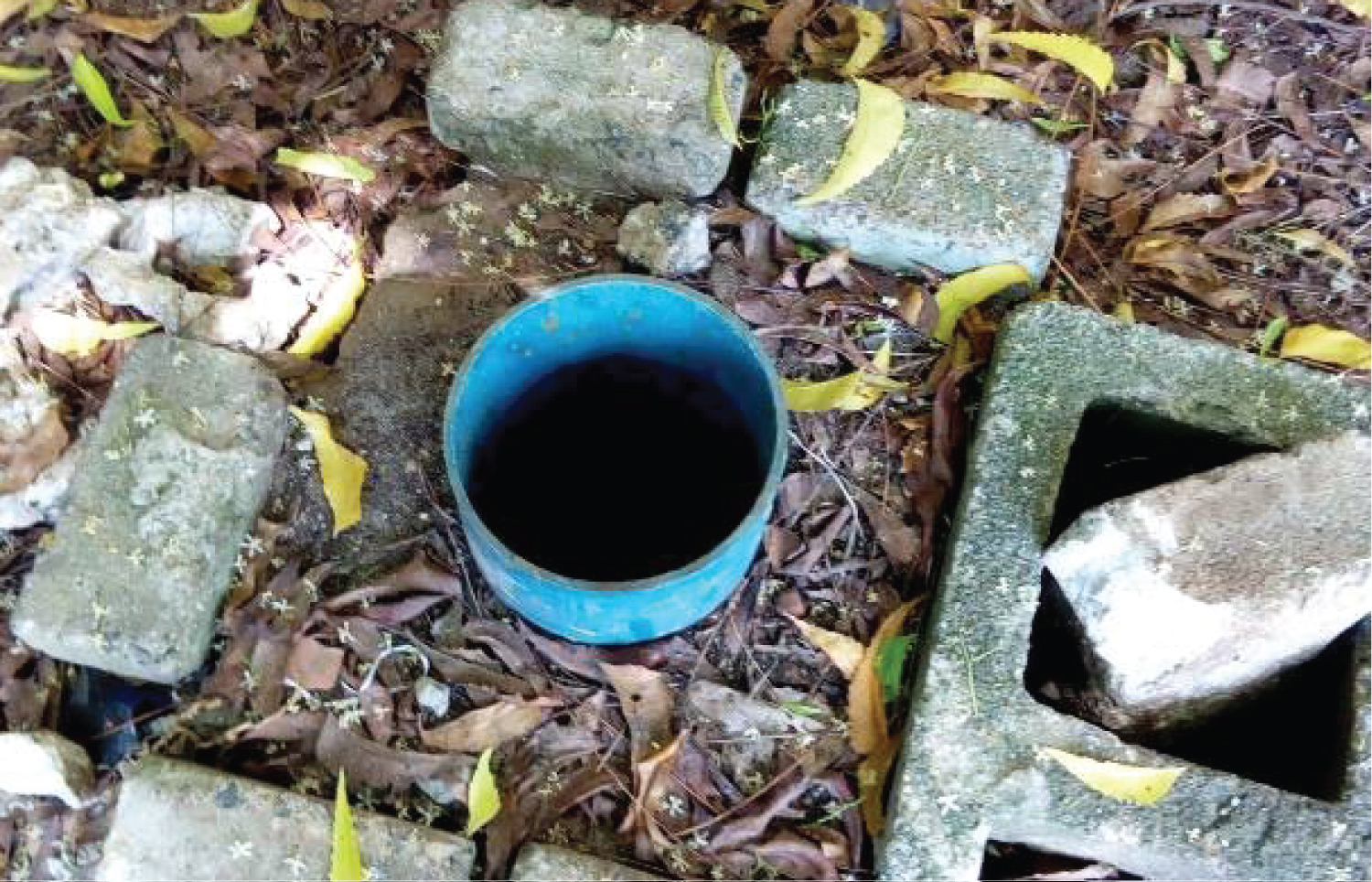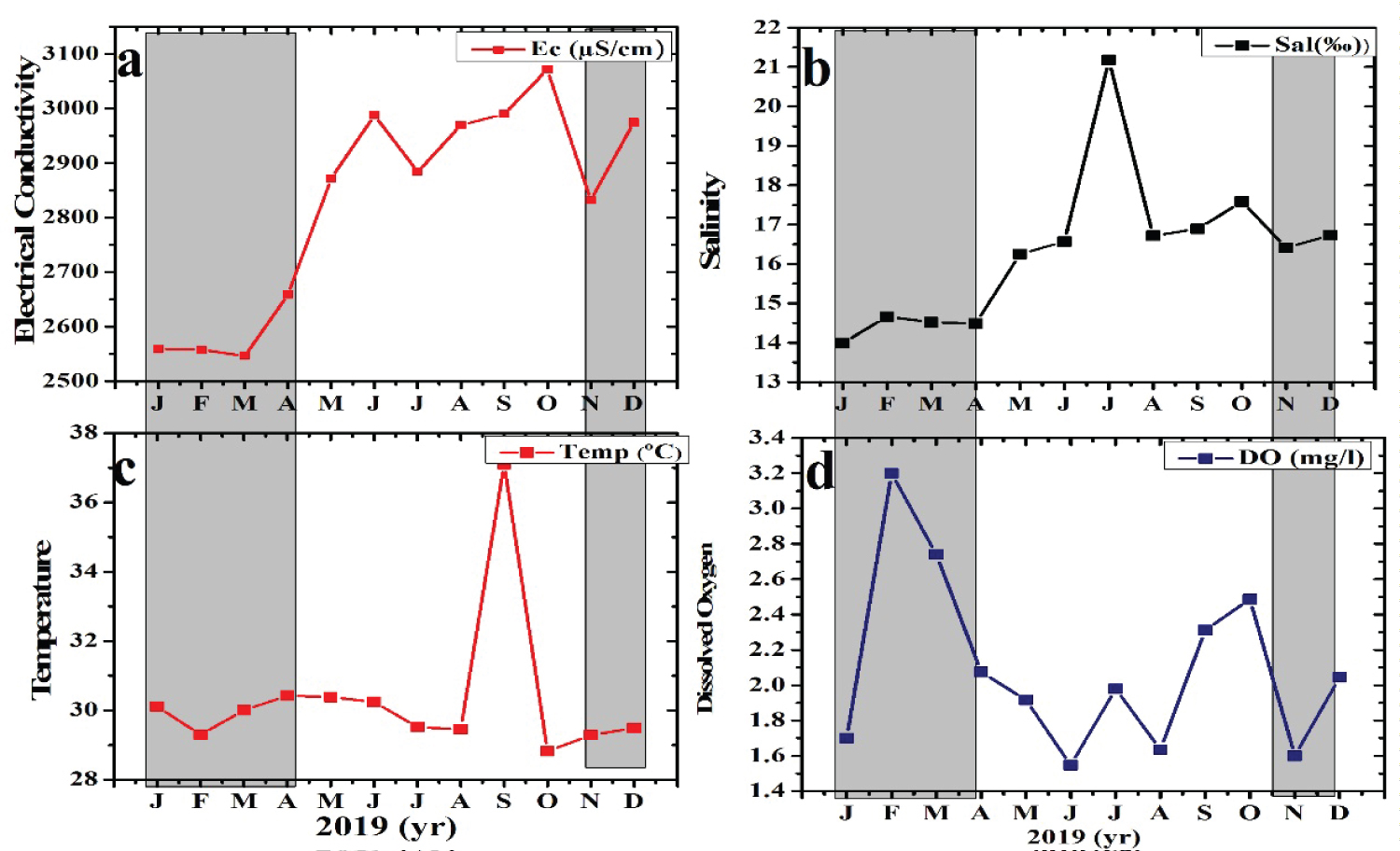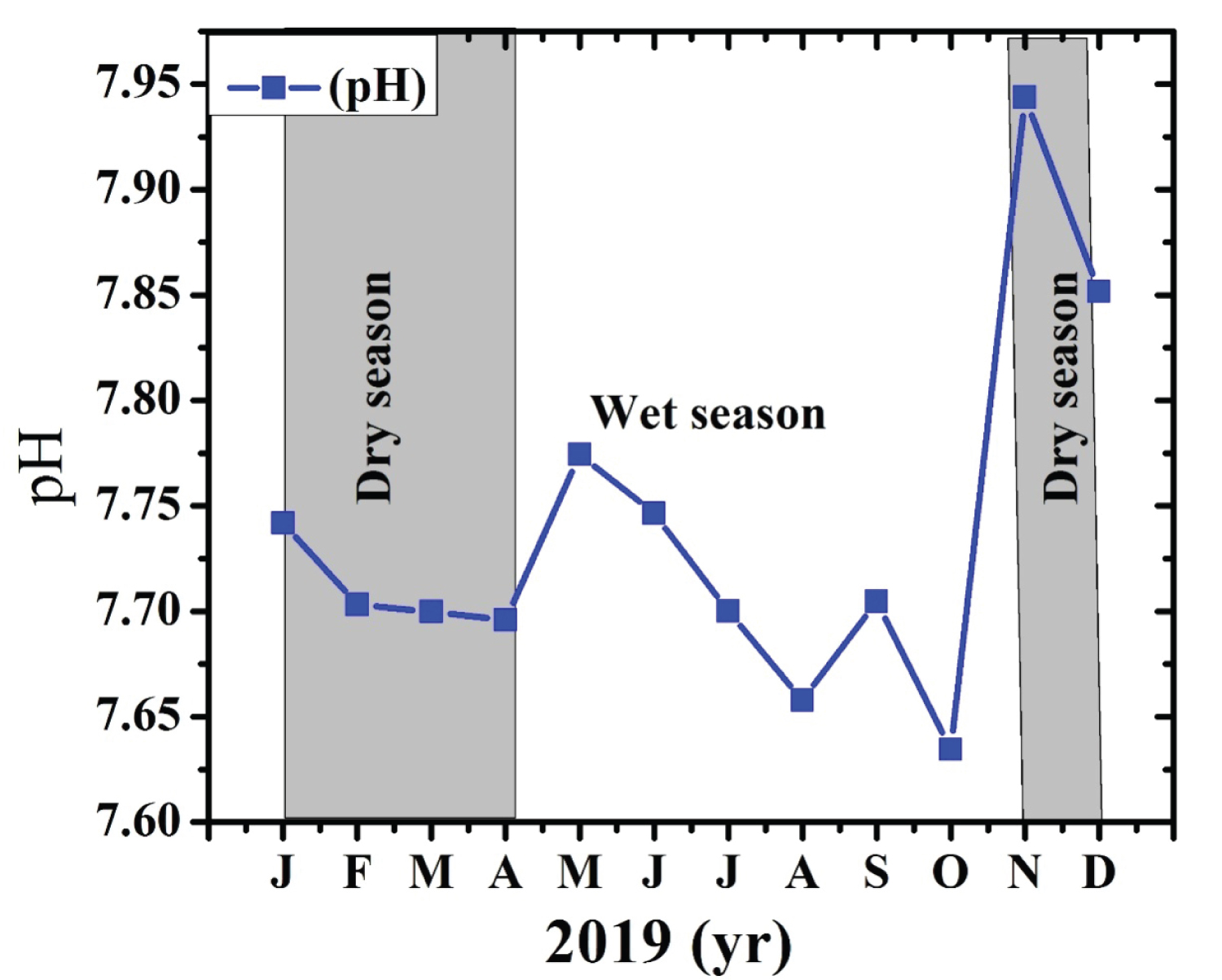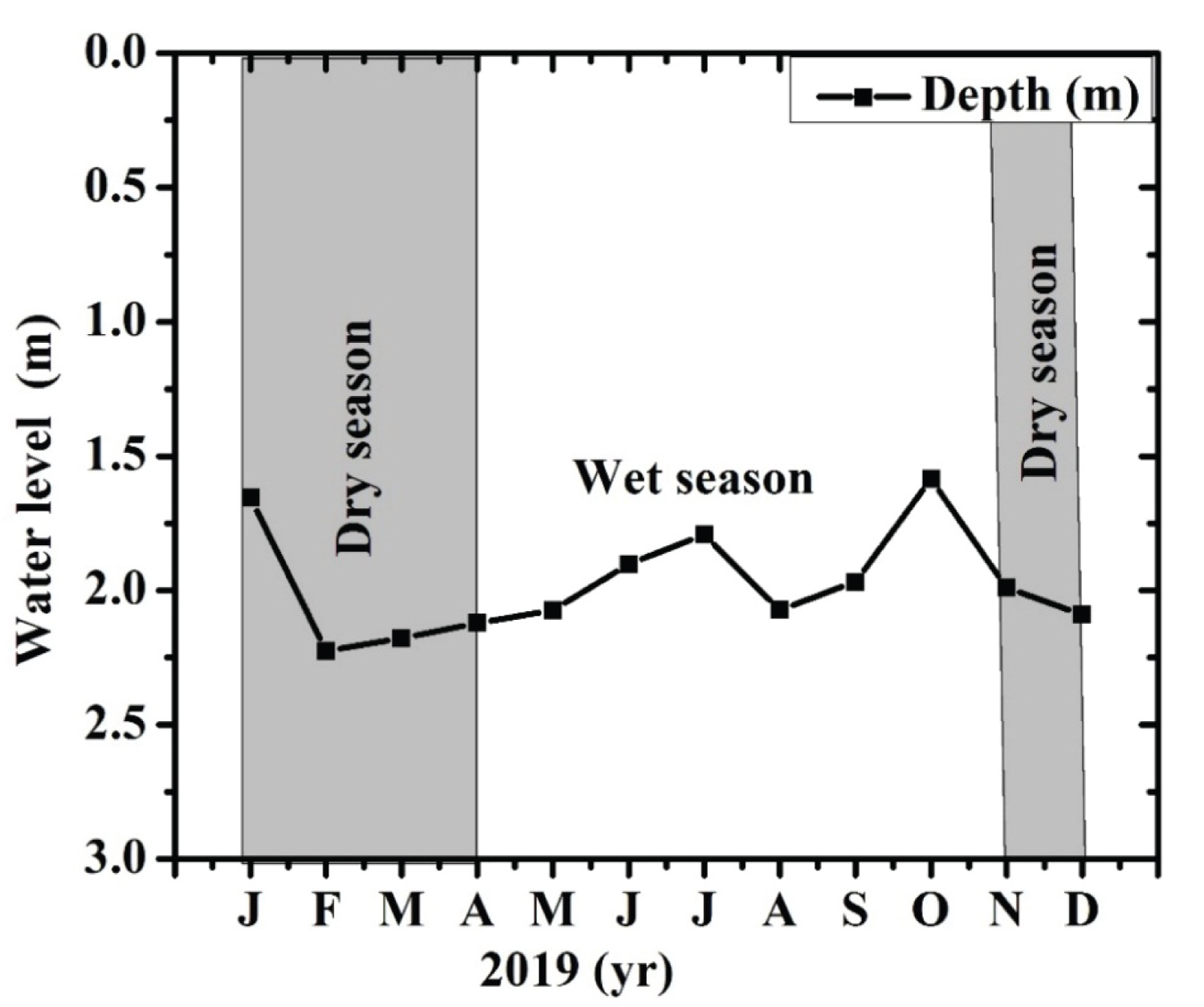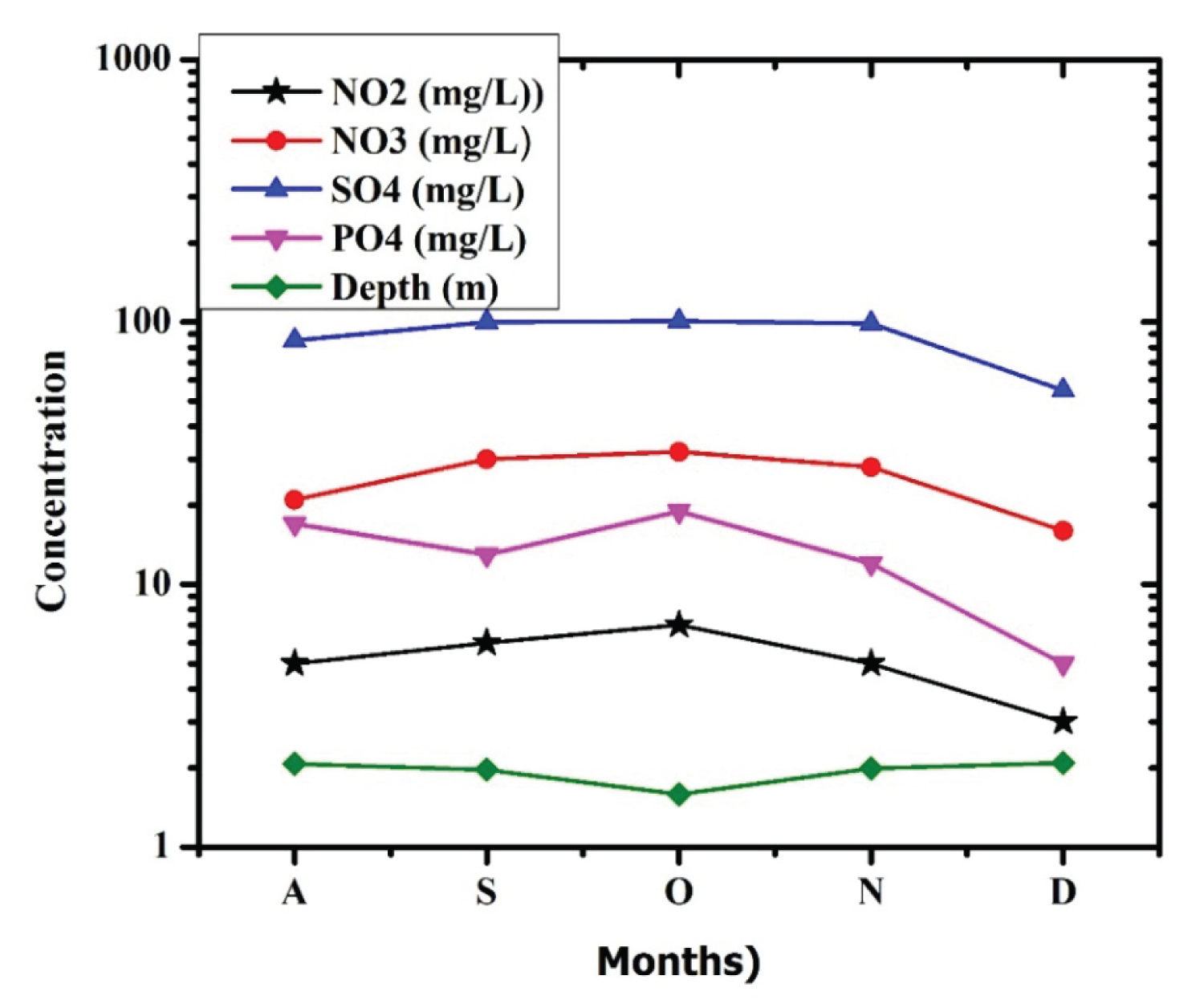Evaluation of Saline Water Intrusion and Suitability of Groundwater for Domestic Purposes in Lagos Coastal Area, SW Nigeria: Using NIOMR Jetty as a Case Study
Abstract
The current study deals with the evaluation of groundwater suitability for domestic purposes within the coastal communities of Lagos, using a 200 feet monitoring borehole at the Nigerian Institute of Oceanography and marine research (NIOMR) Jetty, Southwest Nigeria as a case study. The monitoring borehole water was analysed for physicochemical parameters (pH, electrical conductivity, salinity, dissolved oxygen, temperature) and nutrients (nitrite, nitrate, phosphate, sulphate) from January-December, 2019. A borehole located in the Lagos mainland was used as control. The analytical results showed that the concentration ranges of nitrite (3-7 mg/L), nitrate (16-32 mg/L), salinity (13.99-21.18‰) and electrical conductivity (2545-3072 μS/cm) exceed the permissible limit stipulated by the United State Environmental Protection Agency (USEPA), which are 1 mg/l, 10 mg/L, 0‰ and < 1500 μS/cm for nitrite, nitrate, salinity, and electrical conductivity respectively. The groundwater samples from the control station showed electrical conductivity and salinity ranges of 7.3-73 μS/cm and 0‰ respectively, and which made samples from the control to be classified as freshwater. The high salinity (21.18‰) and electrical conductivity (3072 μS/cm) during the wet season (July, September and October) affirmed the influence of seawater intrusion into the freshwater aquifer of the monitoring borehole. Our study further showed the highest elevated groundwater level (1.58 m) in October, which coincides with the highest electrical conductivity (3072 µS/cm) value in the same month. While the correlation between the groundwater level and electrical conductivity clearly shows evidence of seawater intrusion at the study location, elevated nitrite and nitrate concentrations above the USEPA permissible limits, provide evidence for leachate of seepages from anthropogenic sources. This study has shown not only that subsurface pollutants in the form of saline water intrusion and infiltration of leachates are the major controlling factors of groundwater pollution at the NIOMR Jetty, but it has also revealed an essential insight into the groundwater pollution of the coastal environment of Lagos state, Southwest Nigeria.
Keywords
Groundwater, Physicochemical parameters, Permissible limit, Seawater intrusion, NIOMR Jetty, Southwest Nigeria
Introduction
Almost half of the world's population are living within a 200-400 km radius of the ocean shoreline, area, which has been sand-filled by more than 50% of the earth surface. These coastal dwellers depend largely on groundwater as the main source of freshwater for daily survival, industrial and agricultural purposes. This development has led to excessive groundwater extraction near the coast [1].
The effects of global warming and climatic change require a multi-disciplinary approach that includes the conservation and management of surface and groundwater resources. However, the interrelationship between climate change and groundwater resources is complex, relative to the surface water systems. The linkages between groundwater resources and climate change involve a long term accurate estimation of the direct interactions with the recharge processes, water level variations, fluctuations and distributions [2].
The probability of encountering freshwater in aquifers of coastal areas has been on the decline over time due to the influx of saline water from the sea. Saline water intrusion occurs when saltwater displaces or mixes with fresh groundwater in coastal aquifers due to the density differences between waters of different salinities. It is a common problem associated with every coastal region all over the globe; including Lagos, and other coastal states in the southwest [3].
The Lagos coastal city experiences various degrees of saline intrusion along the coastline. These saline intrusions majorly occur as a result of the sole reliance of the coastal inhabitants on the groundwater as the major source of potable water for domestic and industrial purposes. Fresh and portable groundwater availability however is unevenly distributed, while the available resource has been polluted. Quality of groundwater drops when anthropogenic chemicals that threaten human health enter a water body through run-off, weathering or when the concentration of natural elements fall short of required standard [4].
The sources of groundwater contaminants in the southwest Nigerian coast may be classified into two; (i) Surface contaminants which migrate as leachates into groundwater and (ii) Subsurface pollutants in the form of saline water intrusion [3]. Indiscriminate waste disposal in Lagos coastal areas does not only adversely affect the quality of the accessible shallow groundwater but also poses serious health challenges to the inhabitants of the region who mainly depend on groundwater for their domestic, industrial and agricultural activities.
The demand for water resource of appropriate quality and quantity is of prime importance to the inhabitants and thus the continuous monitoring and assessment of groundwater from shallow boreholes in the coastal environments becomes a primary objective. Additionally, the quality of water is characterized by a range of physicochemical and biological parameters, which are triggered by varieties of anthropogenic and geogenic influences.
Several studies have been conducted on groundwater in the Lagos coast [3,5,6]. Additionally, Aniebone, et al. [7] conducted a study on the assessment of groundwater quality for aquaculture in the Nigerian Institute of Oceanography and marine research. The physicochemical parameters of all these afore mentioned studies were not conducted in-situ on a monitoring borehole, and seasonal (e.g., wet and dry season) variations were not considered. Moreover the low salinity (0‰) and conductivity (0.04-0.08 µS/cm) values reported by Aniebone, et al. [7] from NIOMR Jetty and NIOMR headquarter suggest investigation on treated groundwater samples.
Based on the need for further research on the quality of groundwater within the coastal zone of Lagos, long-term in-situ seasonal monitoring of physicochemical characteristics of groundwater and variations in groundwater levels in response to tidal oscillation/saline water infiltration were carried out in this study to assess the seasonal variations in the quality of samples collected from the monitoring borehole, and its suitability for domestic purposes.
We consider this continuous in-situ groundwater monitoring at NIOMR jetty as the starting point, with its extension to other groundwater aquifers in the coastal areas of Lagos State, southwest Nigeria.
Study Area
Lagos is situated in south-western Nigeria on the West Coast of Africa and is the commercial nerve center of Nigeria. Geologically; it falls within the eastern part of the Dahomey Basin, bounded to the north by then Precambrian Basement complex of southwestern Nigeria. It is bounded by the Gulf of Guinea to the south and eastward by the Okitipupa ridge [8]. Most rivers from south-western Nigeria drain into the Lagos lagoon. Therefore, the occurrence of brackish/saline water is a major feature that characterizes the alluvium and underlying coastal plain sands aquifer contrary to what is obtainable in the mainland of Lagos state. The aquifers of the Lagos coast are adequately recharged with high annual rainfall (mean annual rainfall of over 2000 mm), while the depth to groundwater table is generally below 5.0 m in the coastal area [9].
The Harbour (Figure 1) situated in Lagos is Nigeria's most important seaport and the first inlet from the Atlantic Ocean, beyond the Republic of Benin [10]. It is one of the three main segments of Lagos Lagoon Complex; other segments are Metropolitan and the Epe Division Segments. It is 2 km wide and receives inland waters from the Lagos Lagoon in the north, and Badagry Creek in the west. Oil depots are located along the shore of western parts coupled with the proliferation of urban and industrial establishments on the shore of the eastern part.
NIOMR jetty station (Latitude 6° 25' 14, 88° N, Longitude 3° 24' 24, 42° E) is located in the commodore channel of Lagos Harbour with Jetty facilities awaiting rehabilitation. Subsistence fishing takes place at this part on the water body by artisanal fishermen [11]. A 200 feet monitoring borehole (Figure 2) was drilled at the front of Physical and Chemical Oceanography Department, Nigerian Institute for Oceanography and Marine Research (at ~140 meters from the NIOMR Jetty). Additionally, an existing borehole at Ketu, in the Lagos mainland, (Kosofe local government), at about 200 meters away from a major canal in the area was used as a control station.
Materials and Methods
Groundwater samples were collected from the monitoring borehole with a 1-litre pre-labelled plastic container, attached with ~30 feet rope. Before sampling, all the sampling containers were washed and rinsed with the groundwater. After the sampling process, the sampling bottles were tightly packed and transported immediately to the laboratory for further analysis. Samples were analyzed for pH, electrical conductivity (EC), salinity (Sal), dissolved oxygen (DO), and temperature (TEMP) daily from January to December 2019 (Table 1).
The pH, conductivity, TDS, salinity and temperature were measured in situ using Horiba U-52 multi-water probe. Separate water samples were collected in 250 ml DO bottles and fixed with 2 mls each of Winkler I (manganous-sulphate) and Winkler II (Alkaline Potassium Iodide) and titrated with sodium thiosulphate using starch as an indicator to determine dissolved oxygen according to Popoola, et al. [12]. Nitrite (NO2-), nitrates (NO3-), phosphate (PO43-), and sulphate (SO42-) were sampled for five months (August-November, 2019) and analysed using Smart Water Analysis Lab (LaMotte, MODEL SCL-05).
Water level data were collected at the station from January-December 2019 using HoboWater level logger (Model ANM30pq). The measurements were collected every 30 minutes and mean values over a month are stored, to obtain a monthly set of data.
Results and Discussions
Physicochemical characteristics of groundwater
The physicochemical properties (e.g., salinity, electrical conductivity, dissolved oxygen, temperature, pH) and the hydrochemical characteristics (e.g.., NO2-, NO3-, PO43-, and SO42-) of groundwater are the major factors that determine its suitability for domestic, industrial and agricultural purposes. These results together with the seasonal groundwater level trends are presented in Figure 3, Figure 4, Figure 5 and Figure 6.
Table 2, Table 3, Table 4 and Table 5 shows the comparison of the groundwater hydrochemical characteristics with the World Health Organization standard [13] guidelines for domestic water and the Pearson correlation matrix.
Electrical conductivity
Electrical conductivity (EC) measures the ability of water to pass electric current and is roughly proportional to the concentration of dissolved and inorganic salts. The higher the EC, the higher the salt contents (e.g., saline intrusion) in the groundwater. The most desirable EC permissible limit for domestic use is < 1500 μS/cm [14,15]. Plummer, et al. [16] highlighted three groups of groundwater conductivity values (i) EC < 1500 μS/cm, permissible levels; (ii) 1500 < EC < 3000 μS/cm non-permissible levels; (iii) and > 3000 hazardous state.
The EC concentrations in groundwater at about 140 m from the NIOMR Jetty (Figure 3a) varies from 2871.57-3071.98 μS/cm during the wet season, and 2545.99-2975.00 μS/cm during the dry season (Table 2), indicating that all the values are within the non-permissible limit. However, the EC values for October exceeded 3000 μS/cm, indicating a transition from non-permissible limit to hazardous state in October. This hazardous EC status is not unconnected with the series of high tides and ocean surge in the month, as observed on the 7th, 21st and 22nd October 2019 at the brackish surface water in the NIOMR Jetty. This ocean surge can alter the electrical conductivity values and increased the groundwater pollution in the form of saline water intrusion. These hazardous effects can further be linked to the observed highwater level in October (Table 2) and increased saline water infiltration from the brackish surface of the NIOMR-Jetty into the monitoring borehole. In comparison with the groundwater samples from Ketu (Lagos mainland; Table 3), the EC values ranged from 7-92 μS/cm, which falls within the permissible limit (< 1500 μS/cm) for domestic water.
Salinity
The salinity concentration ranges from 16.25-21.18‰ and 13.00-16.73‰ during the wet and dry season respectively. The salinity values at the control station in Lagos mainland is 0‰ (Table 3), which further indicate the effect of seawater intrusion in the Lagos coast in comparison to the Lagos mainland. The EC showed an expected significant positive correlation with Sal (r = 0.664, Table 4).
Temperature and dissolved oxygen
The temperature and dissolved oxygen are important groundwater quality parameter. High temperature tends to increase the level of turbidity in groundwater, reduce light penetration and causes a reduction in the level of dissolved oxygen (DO). The solubility of oxygen (DO) decreases as temperature increases, additionally, low dissolved oxygen can give some essential insight into the bacterial activities in the groundwater aquifer. The temperature of the NIOMR-Jetty groundwater ranges from 28.82-37.11 ℃ and 29.28-30.43 ℃ during the wet and dry season respectively (Table 2). The high temperature in the groundwater samples (supported by the observed drop-in in the level of rainfall) during September and October coincides with high EC values (arising from reduced dilution of inorganic ions) in the two months (Figure 3a and Figure 3c). The observed DO vary from 1.55-2.49 mg/L and 1.60-3.20 mg/L during the wet and dry season respectively. The DO values showed an inverse trend with the temperature (Figure 4c and Figure 4d). The lowest temperature (29.30 ℃) corresponds to the highest DO (3.20 mg/L) in February. These observed trends suggest reduced groundwater turbidity and increased solubility of oxygen (DO) as temperature decreases and vice versa.
pH
pH can affect the dynamics and chemical species of metals, and alter their availability and toxicity [17]. Acidic pH tends to permits toxic elements and compounds to become mobile and available for uptake and ingestion [18]. The pH of the NIOMR Jetty groundwater varies from 7.63-7.77 and 7.70-7.95 during the wet and dry season respectively (Figure 4a), indicating fresh to alkaline (non-acidic) nature and reduced impact of decaying organic matter during the sampling period. The pH concentrations fall within the permissible limit for drinking water specified as 6.5 to 8.5 [13,19].
The pH and Ec values of this study compared to similar studies in Lagos coast are in the range of the values reported in Apapa, Ikoyi and Victoria Island [3]; but are slightly higher than the values reported by Adewuyi, et al. [5] at CMS and Victoria Island (Table 6). The higher concentration of the physicochemical parameters of our study area compared to the reported values by Ayolabi, et al. [6] and Oloruntoba [20] in University of Lagos and Badagry axis suggest an enhanced influence of seawater intrusion, based on the closer proximity of the NIOMR jetty stations to the Atlantic Ocean.
Seasonal trends in the groundwater level and anion concentrations
Groundwater levels are not often constant but may change slightly depending on the response to tidal oscillation, and proximity to the Lagoon or creeks, or sites of industrial effluents, internal erosions or the influence of saline water [3].
The groundwater-level varies from 1.58-2.07 m and 1.66-2.23 m during the wet and dry season respectively (Table 2). The lowest groundwater level (2.23 m) occurred in February during the dry season, which coincides with the highest DO values in the same month. Meanwhile, the lowest groundwater level during the wet season occurred in May and August (Figure 5). The highest groundwater level (1.58 m) in October (wet season) coincides with the lowest pH (7.63) and highest EC (3072 µS/cm) in the same month (Figure 4 and Figure 5).
Enriched nitrite levels in drinking water are often caused by groundwater contamination from seepage of human sewage from private septic systems, animal waste run-off and use of fertilizers. They often stimulate the growth of bacteria when introduced in high levels into the groundwater. The permissible limit for nitrite in drinking water is < 1.0 mg/L [21]. Nitrite concentration of the groundwater samples in the monitoring borehole from August to December 2019 is in the range of 3-7 mg/L and exceeded the USEPA permissible limit for drinking water [21]. The occurrence of the highest nitrite values (7.0 mg/L) in October coincides with the highest water level in the same month, which suggest excessive surface migration of leachates arising from human sewage or animal waste run-off into groundwater during the sampling period.
Excessive nitrate concentrations (> 45 mg/L) in groundwater is of great concern to human health [19], while the United State Environmental Protection Agency [21] stipulated < 10 mg/L of nitrate concentration is safe for domestic use. High nitrate levels in the groundwater could be caused by infiltration of nitrogen-rich flood water arising from the use of nitrogen-containing fertilizers, domestic sewage, municipals discharge, animal manure used on cropland. Nitrate concentration of the groundwater samples in the monitoring borehole from August to December 2019 is in the range of 16-32 mg/L and exceeded the USEPA permissible limit for drinking water Table 5, [21]. Nitrate shows a significant positive correlation with DO (r = 0.516, Table 4), which suggest the influence of nitrates on the dissolved oxygen distributions of the monitoring borehole. The sulphate concentrations in the groundwater samples from August to December 2019 vary from 55 to 101 mg/L (Table 3), which is below the permissible limit of 400 mg/L [22]. Sulphate shows a significant positive correlation with nitrite (r = 0.896), nitrate (r = 0.941) and phosphate (r = 0.754, Table 4), which suggest a similar anthropogenic source to the enrichments of the four nutrients in the monitoring borehole.
Anthropogenic effluents and wastewater from chemical fertilizer and run-off that are composed of dissolved and suspended phosphate have often led to enhanced phosphate concentration in groundwater. Phosphates is a food additive, and are considered to be generally safe, however, its enhanced concentration can cause health problems, such as kidney damage. The phosphate concentration in the groundwater samples from August (A) to December (D), 2019 vary from 5 to 17 mg/L. The water level data from A to D was plotted with the hydro-chemical variables (NO2-, NO3-, PO43-, and SO42-) of that month (Figure 6), and showed similar trends especially with the nitrate and sulphate during these periods. These similar trends suggest leachates and saline water intrusion as the controlling factors of physicochemical and hydro-chemical variables (e.g., cations and anions) of groundwater in the NIOMR Jetty.
Conclusion
The main objective of the study was to assess the groundwater quality for drinking purpose and to have an insight into the effect of saline intrusion into the coastal aquifer of Lagos coastal areas, south-west Nigeria. The monitoring borehole sunk at ~140 m from the Nigerian Institute of Oceanography and Marine Research-Jetty (NIOMR Jetty) was used as a case study. In other to achieve this, we studied the physicochemical properties (pH, electrical conductivity (Ec), salinity (Sal), dissolved oxygen (DO), and temperature (Temp) from January to December in 2019, and nutrients (Nitrite (NO2-), Nitrates (NO3-), phosphate (PO43-), and sulphate (SO42-) distributions for four months (August-November, 2019). A control borehole was sampled in the mainland axis of Lagos, southwest Nigeria. Our results indicate that the groundwater in the study area is alkaline. The Physico-chemical characteristics of the monitoring boreholes reveal that pollution affecting the water table is controlled by surface contaminants which migrate as leachates into groundwater and sub-surface pollutants in the form of saline water intrusion. These two factors are evident from the low dissolved oxygen, elevated nitrite and nitrate concentration, enriched salinity and electrical conductivity values majorly in the wet season as a result of seawater intrusion into the groundwater aquifer. This study has further shown that continuous monitoring of the physicochemical parameters and hydrochemical variables is essential for effective management of subsurface contaminants that could serve as threats to groundwater resources within the coastal environment.
Acknowledgments
The authors wish to acknowledge other researchers in the Department of Physical and Chemical Oceanography of the Nigerian Institute for Oceanography and Marine Research (NIOMR) for their cooperation during the sampling period. We are particularly grateful to the management of NIOMR. We also appreciate the support of Dr. Adeleye Adedayo Oluwaseun during the sampling process and the anonymous reviewer for the helpful comments that have greatly improved the manuscript.
References
- Hinrichsen D (2007) Ocean planet in decline. People and the planet.
- Kumar CP (2012) Climate change and its impact on groundwater resources. International Journal of Engineering and Science 1: 43-60.
- Yusuf MA, Abiye TA (2019) Risks of groundwater pollution in the coastal areas of Lagos, southwestern Nigeria. Groundwater for Sustainable Development 9.
- Anudu GK, Obrike SE, Onuba LN, et al. (2011) Hydro-geochemical evaluation of groundwater resources from hand-dug wells around Kakuri and its environs. Kaduna State Northcentral Nigeria, 75-85.
- Adewuyi GO, Oputu OU, Opasina MA (2010) Assessment of groundwater quality and saline intrusions in coastal aquifers of lagos Metropolis, Nigeria. Journal of Water Resource and Protection 2: 849-853.
- Ayolabi EA, Folorunso AF, Odukoya AM, et al. (2013) Mapping saline water intrusion into the coastal aquifer with geophysical and geochemical techniques: The university of lagos campus case (Nigeria). Springerplus 4: 433.
- Aniebone VO, Mohammed R, Nwamba EE, et al. (2018) Assessment of groundwater quality at the Nigerian institute for oceanography and marine research: Implication for production of aquaculture. Global Journal of Geological Sciences 16: 19-23.
- Omatshola ME, Adegoke OS (1981) Tectonic evolution and cretaceous a stratigraphy of the Dahomey Basin. Journal of Mining and Geology 54: 65-87.
- Offodile ME (1992) An approach to groundwater study and development in Nigeria. Mecon Geology and Engineering Services Ltd., Jos.
- Popoola SO, Nubi OA, Adekunbi FO, et al. (2015) Vertical profiling and contamination risk assessment of some trace metals in part of the Lagos Lagoon axis. International Journal of Science, Technology and Society 3: 186-193.
- Balogun KJ, Adedeji AK, Ladigbolu IA (2014) Primary production estimation in the euphotic zone of a tropical harbour ecosystem, Nigeria. International Journal of Scientific and Research Publications 4: 1-8.
- Popoola SO, Udochu U, Adekunbi FO, et al. (2015) Spatial variations in the physicochemical parameters of some selected locations in Lagos Lagoon, South-Western Nigeria. Journal of Science 5: 1354-1359.
- WHO (2006) Guideline for drinking water quality, 1st Ed. Addendum to the third ed., Recommendations. World Health Organization, Geneva, 515.
- WHO (1983) International standards for drinking water. World Health Organization, Geneva.
- WHO (2004) Guidelines for drinking-water quality. 3rd edn, World Health Organization, Geneva 1.
- Plummer LN, Bexfield LM, Anderholm SK (2003) How ground-water chemistry helps us understand the aquifer. In: Bartolino JR, Cole JC, US Geological Survey Circular, 1222.
- Department of Water Affairs and Forestry (1996) Water quality guideline for domestic use. 2nd edn, DWAF, Pretoria 1.
- Rukeh AR (2013) Physico-chemical and biological characteristics of stagnant surface water bodies (ponds and lakes) used for drinking and domestic purposes in Niger Delta, Nigeria. Journal of Environmental Protection 4: 920-928.
- WHO (1984) The guidelines for drinking water quality recommendations. World Health Organization, Geneva.
- APHA (2017) Standard methods for the examination of water and wastewater. 23rd edn, American Public Health Association, American water works association and water environmental federation, Washington DC.
- The United States Environmental Protection Agency (2003) The incidence and severity of sediment contamination in surface waters of the United States. National Sediment Quality Survey. Washington, Columbia.
- WHO (1990) Environmental health criteria 81: Vanadium [R]. World Health Organization, Geneva, 1-35.
Corresponding Author
Samuel Olatunde Popoola, Department of Physical and Chemical Oceanography, Nigerian Institute for Oceanography and Marine Research, PMB, 12729, Victoria Island, Lagos, Nigeria.
Copyright
© 2020 Popoola SO, et al. This is an open-access article distributed under the terms of the Creative Commons Attribution License, which permits unrestricted use, distribution, and reproduction in any medium, provided the original author and source are credited.

